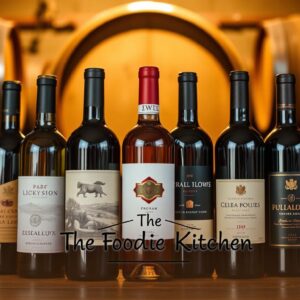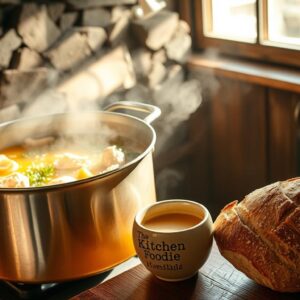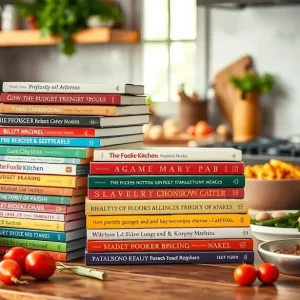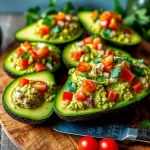Learning to bake is like unlocking a secret code—part science, part creativity. We’ve made this guide to make every step easy, from mixing dough to baking your first loaf. Whether you’re seasoning foods or making flaky pie crusts, we mix old ways with new ones.
The 2nd Edition of Mastering the Art and Craft of Baking and Pastry is huge, with 932 pages. It has 60 new pages since 2004, with new cookie recipes and diagrams. Even Bear Claws now get a spot in the breakfast chapter, showing today’s trends.
We want to make you feel confident in the kitchen. Start with Snacking Bakes, with quick recipes using what you already have. Check out BakeWise for 200+ tips or Chad Robertson’s guide to Tartine Bread. Every recipe here, from Shirley Corriher’s science to Erika Council’s Still We Rise biscuits, focuses on being clear and successful.
With popular cookbook recipes like those in Advanced Bread and Pastry, you’ll see how charts and visuals make complex steps easy. And don’t miss Nicola Lamb’s upcoming Sift, joining her 53,000 subscribers eager to learn.
Whether you bake on weekends or want to master holiday classics, this guide is for you. From best cookbook recipes like Ken Forkish’s yeast techniques to Roxanna Jullapat’s Mother Grains, every resource here is both deep and simple. Remember, even the most popular cookbook recipes began as experiments. Let’s make your kitchen a place of discovery, one bowl, one recipe, one success at a time.
Essential Baking Equipment Every Novice Baker Needs
Starting your baking journey? The right tools are key for homemade cookbook recipes. First, get a digital kitchen scale—it’s crucial for accurate measurements. Then, add sturdy measuring cups and spoons for exact portions.
A stand mixer or hand mixer, like the OXO Good Grips 5-Speed, makes mixing easier. Don’t forget silicone spatulas, whisks, and mixing bowls in different sizes.
Bakeware is a must. Get two 8- or 9-inch cake pans, a 9×13-inch dish, and a half-sheet pan. Choose heavy-gauge metal for even heat. An oven thermometer is vital for recipes that need precise temperatures.
Sifters, like the Mrs. Anderson’s Hand Crank or Cuisinart sieves, are important. They help keep ingredients light and airy, perfect for flaky pie doughs or fluffy cakes.
Start with 14 essential tools, including rubber spatulas, cooling racks, and a rolling pin. Look for brands like Wilton and USA Pan for durable options. A 10-inch cast iron skillet, at $15+, is great for both savory dishes and rustic breads.
Focus on quality over quantity. Invest in a few premium items before adding more specialized tools. This foundation helps you make everything from quick breads to recipes that need precision. Practice mise-en-place with these tools to avoid last-minute scrambles.
Understanding Baking Ingredients and Their Functions
Mastering easy cookbook recipes starts with knowing how each ingredient works together. Let’s explore their roles to build confidence in the kitchen. Ingredients like flour, leaveners, and fats aren’t just ingredients—they’re building blocks for texture and structure.
Flour types determine your final product. Cake flour’s low protein (around 8%) creates delicate layers, while bread flour’s 12-14% protein strengthens gluten for chewy loaves. All-purpose flour (10-12%) is the middle ground for most easy cookbook recipes. Always follow the recipe’s choice—substitutions change outcomes.
Leavening agents work through chemistry. Baking soda needs acid (like yogurt or lemon juice) to react, while baking powder has its own acid. Yeast, a living organism, needs warmth and time to rise dough. Using the right type ensures proper rise without collapse.
Fats like butter or oil add moisture and tenderness. Room-temperature butter (65–70°F) mixes air best, creating fluffy batters. Eggs stabilize mixtures—yolks emulsify, whites add lift. Sugar does more than sweeten: creaming it with fat creates tiny air pockets, leading to lighter cakes. Even sugar’s molasses content in brown sugar affects moisture and flavor.
Temperature and technique matter. Cold ingredients won’t blend as well—always bring eggs and butter to room temp. Salt strengthens gluten and balances flavors, while vanilla enhances depth. These details turn following cookbook recipes into science-backed actions, not guesswork. With this knowledge, you’ll avoid common pitfalls and adapt recipes with skill.
The Science Behind Successful Baking
Learning the science of baking makes you more confident. It’s all about the steps when making homemade cookbook recipes. Flour, butter, and sugar are more than just ingredients. They are the foundation of your baked goods.
When you mix them, gluten forms, shaping the texture. Too much mixing makes the dough tough. Not enough mixing can make it weak.
Leavening agents like baking soda and baking powder are waiting for the right moment to react. Baking soda needs acid to work, while baking powder can handle neutral flavors. Temperature also plays a big role: cold butter makes pie dough flaky, and room-temperature eggs make cakes smooth.
Books like How Baking Works and Ratio show why certain ratios, like 1:2:3 for shortbread, are perfect. Shirley O. Corrihan’s reverse-creaming method ensures fat is evenly distributed in cakes. Science helps solve problems too: a sunken cake might mean the oven was too hot or you opened the door too soon.
With this knowledge, you can make homemade cookbook recipes with confidence. You can adjust recipes from The Baker’s Appendix or try new flavor combinations from The Flavor Bible. Start with simple recipes and then experiment with different ingredients. Every step brings you closer to becoming a master baker.
Foundational Cookbook Recipes Every Beginner Should Master
Starting with basic baking recipes is key. Our top picks focus on simple techniques. Begin with basic bread dough, made from flour, water, yeast, and salt. Kneading helps build the dough’s structure.
A perfectly risen loaf will sound hollow when tapped. This is a skill every baker needs to learn.
Pastry dough requires precision. Cold butter and gentle handling create flaky layers. Our favorite recipes include pie and tart crusts, which need patience for crisp results.
For cakes, a yellow cake shows the creaming method. Chocolate cakes highlight how ingredients interact. Cookie doughs teach how baking time changes texture from chewy to crisp.
These recipes connect to trusted sources like Kitchen Foodie’s community. Mark Bittman’s How to Cook Everything and Alice Waters’ The Art of Simple Food guide you step-by-step. Knowing when something is done is crucial: a toothpick clean of cake batter or a 200°F internal temp for bread.
Mastering these basics boosts confidence. Each recipe is a tool for creativity. Every step, from kneading to testing dough, improves your skills.
Start small and perfect one recipe before moving on. This approach ensures techniques stick. It turns beginners into confident bakers ready for more complex recipes.
Healthy Cookbook Recipes for Nutritious Baking
Make baking a healthy habit without losing flavor. Our Mediterranean-inspired cookbook recipes show how whole grains like white whole wheat, spelt, and buckwheat can add texture and nutrition. Swapping refined sugars with mashed bananas, applesauce, or date paste balances sweetness while cutting processed ingredients. These methods work across dishes—from zesty lemon cakes to whole-grain muffins—without requiring complicated techniques.
Measuring matters. Use kitchen scales for precision or the dip-and-sweep method for dry ingredients: dip your measuring cup into flour, then sweep excess with a knife. This ensures consistency when experimenting with substitutions. Our guides include adjustments for liquid ratios when using applesauce or yogurt as egg replacers. Nutritional info and customization tips accompany every recipe, making it easier to align meals with dietary goals.
Explore options like almond flour in cookies or flaxseed in pancakes. Even small swaps—like reducing sugar by 25% or using dark chocolate—preserve taste while boosting fiber and vitamins. Healthy cookbook recipes also highlight seasonal produce, such as autumn apples or winter citrus, to maximize freshness and cost savings. Whether adapting classics or trying new creations, focus on balance: a square of dark chocolate in oatmeal cookies still counts as a treat that fuels your body.
Professional chefs and dietitians recommend these methods for approachable nutrition. Books like “The Extra Virgin Kitchen” and “Nourishing Traditions” offer further insights, but start small. Every swap you try builds confidence to refine your favorite recipes. Healthy baking isn’t about restriction—it’s about creative, wholesome choices that keep your kitchen both joyful and nourishing.
Quick and Easy Cookbook Recipes for Busy Weeknights
Weeknight baking doesn’t have to be stressful. Our quick recipes are fast and flavorful. Start by prepping everything before you start cooking. This makes your evening in the kitchen more relaxed.
Try our moist chocolate snack cake or savory herb biscuits. They’re ready in under 30 minutes. These recipes show that even busy people can make homemade meals.
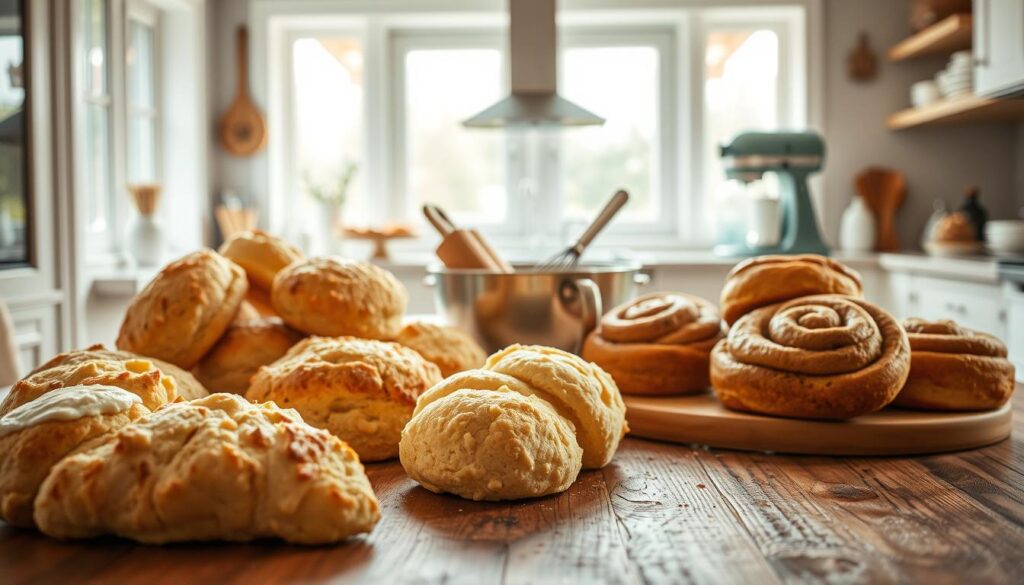
For quick meals, check out Bistro Cooking by Patricia Wells. It’s been a top pick for fast meals since the 1990s. Skillet dinners and sheet-pan meals are great for saving time without losing flavor.
Our recipes include freezer-friendly dishes like Chicken Schnitzel and quick Stir-Fried Pork with Green Beans. These ideas are budget-friendly and practical, just like “Good Food, Good Life” suggests.
Save time by preparing ahead. Mix dry ingredients for quick breads on Sunday or freeze cookie dough. Chrissy Teigen’s recipes, like maple-roasted carrot salad, show you can cook quickly without sacrificing taste.
Even classic dishes like Roasted Chicken with Gravy can be weeknight favorites when simplified. Our guide offers 120+ kid-friendly recipes and vegetarian options from “Keepers” and “Family.”
Each recipe includes tips for oven preheat and tool use. The Chicken & Chorizo Paella example shows how to cut down on steps while keeping flavor. These tips make 30 minutes a chance to enjoy homemade meals. Quick recipes are smart, flavorful solutions for busy lives. Start with a 20-minute snack cake or sheet-pan veggies tonight. Your kitchen is ready!
Vegetarian and Plant-Based Baking Alternatives
Plant-based baking is now easier than ever. More than 300% more people are trying vegetarian recipes. They’re looking for health benefits like a 30-50% lower risk of chronic diseases. Our recipes offer both nutrition and flavor, making sure you enjoy moist cakes, fluffy pancakes, and rich frostings.
Learning about substitutes is key. Aquafaba, the liquid from chickpeas, becomes stiff peaks for meringues. Flax “eggs” (1 tbsp ground flax + 3 tbsp water) help bind cookies and muffins. Coconut milk makes brownies richer, while almond milk makes crepes lighter.
Texture and taste are crucial. Toasted nuts add depth, and spices like cinnamon or cardamom make things special. Our recipes, like vegan banana bread or fudgy brownies, use common ingredients. Even classic desserts like layer cakes and pies get a plant-based makeover.
Check out our vegan dessert collection for 40+ options. It includes no-bake and gluten-free choices. For more help, our comprehensive guides explain ingredient science and how to fix common issues. With 40% of Americans eating less meat, these tips make adapting any recipe easy.
Troubleshooting Common Baking Disasters
Even the best troubleshooting guides show that baking mishaps are common. Our tips turn mistakes into learning moments. Let’s look at why cakes collapse or cookies spread, and how to fix them using popular cookbook recipes.
Start by mastering the creaming method. Softened butter and sugar must beat until light, not just mixed. Overmixing batter or wrong oven temps can cause dense cakes or cracked bread.
Common issues come from overlooked details. For example, using room-temperature ingredients is key. Also, check dough growth visually—indent tests and two-thirds expansion matter more than timers. If cookies spread too much, ensure butter isn’t too warm.
Remember the 2008 incident where a cookbook recipes error omitted butter in ingredients, causing confusion. Always double-check ingredient lists!
Prevent disasters by adapting techniques. Use a casserole pot for steam to mimic bakery crusts. Overbaked goods? Reduce oven temps and monitor color. Overproving dough leads to wrinkled crusts? Adjust timing.
Our community shares fixes like repurposing dry cookies into crusts or turning sunken cakes into trifle bases. Stay vigilant: measure flour correctly, avoid substituting without testing, and learn from past errors. Precision and patience transform baking struggles into successes.
Seasonal Baking: Adapting Recipes Throughout the Year
Seasonal baking makes your kitchen feel in tune with nature. Recipes like the Turmeric Citrus Snack Cake highlight winter’s fresh citrus and spices. Adapting recipes to each season boosts both taste and creativity.
In summer, fruits like berries need extra help to avoid being soggy. Chilling dough and adjusting oven temperatures helps fight off summer heat. Autumn brings apples and spices like cinnamon, which require careful selection.
Our guides show how to toast spices to bring out their flavors. Winter’s citrus fruits are perfect for cookies and cakes, with zesting techniques found in top recipes.
For those at high altitudes, Savor the World Global Bites offers tested adjustments. This book has 24 global recipes with tips for altitude and seasonal pairings. It’s great for using local ingredients.
Seasonal baking is more than just using the right ingredients. It’s about knowing when to use convection modes or tweak leavening agents. Start with our tested techniques, then try new things with your local harvest. Every season brings new chances to enjoy nature’s bounty through baking.
Your Journey Forward: Building Confidence Through Practice and Experimentation
Every step in the kitchen is a chance to grow. Start by revisiting Julia Turshen’s insights on intuitive cooking—trust your senses and adapt easy cookbook recipes to suit your pantry. Remember, 70% of home cooks gain confidence through regular practice, and 90% learn most from their “failures.” Let those lessons guide your next attempt.
Begin with simple homemade cookbook recipes and build from there. Raeanne Sarazen’s work shows that mastering basics like folding batter or balancing flavors unlocks creativity. Her book emphasizes that baking’s science blends with personal flair—whether modifying gluten-free blends or experimenting with global spices. Over 75% of cooks find joy in exploring new cuisines, so tweak a classic dish with your favorite herbs or adjust sweetness levels to make it uniquely yours.
Join a baking group or take our free knife skills class to connect with others. Share your creations and swap tips—this community support helps 65% of cooks improve faster. Keep a journal to track what works, like the 55% who gained confidence through technique mastery. And don’t forget: cooking at home saves 50% on meals while building lifelong skills.
Explore Raeanne’s Complete Recipe Writing Guide for advanced techniques or adapt her methods to create your own easy cookbook recipes. Every bowl mixed, every mistake noted, moves you closer to culinary freedom. The goal isn’t perfection—it’s the joy of sharing meals that nourish both body and soul. Your kitchen is your canvas. Start creating today.
Source Links
- https://cookingbythebook.com/cookbook-reviews/mastering-art-craft-baking-pastry/
- https://www.seriouseats.com/best-baking-cookbooks-8669768
- https://bakerbettie.com/essential-baking-equipment/
- https://sallysbakingaddiction.com/14-kitchen-tools-every-baker-needs/
- https://www.seriouseats.com/guide-to-essential-baking-tools
- https://www.thespruceeats.com/baking-ingredient-science-481226
- https://www.allrecipes.com/article/essential-baking-ingredients/
- https://bakeschool.com/5-science-baking-cooking-books-satisfy-inner-nerd/
- https://thebakersalmanac.com/baking-science-books/
- https://www.epicurious.com/shopping/5-science-books-every-cook-should-read
- https://www.seriouseats.com/introductory-first-cookbooks
- https://www.foodandwine.com/recipes-for-beginners-6400713
- https://www.newyorker.com/books/page-turner/fifteen-essential-cookbooks
- https://www.bbcgoodfood.com/review/16-of-the-best-healthy-cookbooks-to-buy
- https://ellymcguinness.com/blog/best-healthy-cookbook/
- https://www.foodandwine.com/lifestyle/cookbooks-weeknight-cooking
- https://simplehomeedit.com/recipe/dinner-ideas-for-busy-weeknights/
- https://www.loveandlemons.com/plant-based-recipes/
- https://rainbowplantlife.com/best-vegan-desserts/
- https://www.bbcgoodfood.com/howto/guide/baking-sos-how-solve-10-common-bread-problems-luis-troyano
- https://www.theguardian.com/lifeandstyle/wordofmouth/2011/sep/19/cookbook-errors-recipes-for-disaster
- https://www.kingarthurbaking.com/blog/2022/04/01/april-fools-baking-disasters
- https://heavytable.com/seasonal-and-local-cookbooks-how-they-stack-up/
- https://ask.metafilter.com/315195/Seasonal-cookbooks-similar-to-Mark-Bittmans-Kitchen-Express
- https://mountainmamacooks.com/favorite-high-altitude-baking-cookbooks-2/
- https://girlucutebutcanucook.com/from-novice-to-pro-my-journey-as-a-self-taught-home-cook/
- https://foodistkitchen.com/
- https://soundbitesrd.com/podcast-episode-264-key-ingredients-for-success-how-to-develop-write-test-modify-recipes-raeanne-sarazen/
